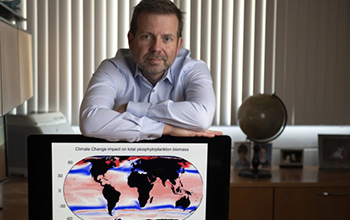搜索结果: 1-15 共查到“海洋生物学 phytoplankton”相关记录154条 . 查询时间(0.144 秒)
The 'phytoplankton factory' -- from nutrients to algae growth
phytoplankton ocean ecosystems climate change
2021/8/9
Phytoplankton are the foundation of ocean ecosystems: like rainforests, they consume carbon from the atmosphere, form the basis of the marine food web and have a decisive influence on fish abundance a...

Oceanographers predict increase in phytoplankton(图)
Oceanographers predict increase phytoplankton
2020/2/20
A neural network-driven Earth system model has led University of California, Irvine, oceanographers to a surprising conclusion: Phytoplankton populations in low-latitude waters may well expand by the ...
Researchers track effects of changing ocean temperature on phytoplankton
Researchers changing ocean temperature phytoplankton
2016/11/4
Changes in ocean temperature affect a key species of phytoplankton, according to scientists at the Woods Hole Oceanographic Institution (WHOI) funded by the National Science Foundation (NSF).Their stu...
Intensity of desert storms may affect ocean phytoplankton
desert storms ocean phytoplankton
2015/9/8
Each spring, powerful dust storms in the deserts of Mongolia and northern China send thick clouds of particles into the atmosphere. Eastward winds sweep these particles as far as the Pacific, where du...
Grazing and Zooplankton Production as Key Controls of Phytoplankton Production in the Open Ocean
Coast phytoplankton pigment waters physical oceanography
2015/8/17
Thanks to NASA's Coastal Zone Color Scanner (CZCS, 1978-1986), nearly ocean-wide coverage of the distribution of phytoplankton pigment in the upper part of the euphotic zone and, in effect, in the mix...
Simultaneous Imaging of Phytoplankton and Zooplankton Distributions
Phytoplankton Zooplankton Distributions
2015/8/6
Understanding the dynamics of the relationship between phytoplankton and higher trophic levels is necessary for understanding the transfers of matter and energy through planktonic food webs. There hav...
Intense Benthic Grazing on Phytoplankton in Coral Reefs Revealed Using the Control Volume Approach
Coral Reefs Revealed Control Volume Approach
2015/8/5
What is our international investment in oceanography, and how has it changed over the years? Two seemingly simple questions that have daunted our community repeatedly. The first of these two questions...
Over the past 100 years Scripps Institution of Oceanography has been a center for plankton research. Its reputation has waxed and waned depending largely on the scientists present, and their ability t...
Ocean acidification may cause dramatic changes to phytoplankton
Ocean acidification cause dramatic changes phytoplankton
2015/8/4
Oceans have absorbed up to 30 percent of human-made carbon dioxide around the world, storing dissolved carbon for hundreds of years. As the uptake of carbon dioxide has increased in the last century, ...
Sixty Years of Sverdrup:A Retrospective of Progress in the Study of Phytoplankton Blooms
Sixty Years of Sverdrup Phytoplankton Blooms
2015/7/17
One of the most dramatic large-scale features in the ocean is the seasonal greening of the North Atlantic in spring and summer due to the accumulation of phytoplankton biomass in the surface layer. In...
Comparative responses of two dominant Antarctic phytoplankton taxa to interactions between ocean acidification, warming, irradiance, and iron availability
two dominant Antarctic phytoplankton taxa ocean acidification warming irradiance iron availability
2014/10/16
We investigated the responses of the ecologically dominant Antarctic phytoplankton species Phaeocystis antarctica (a prymnesiophyte) and Fragilariopsis cylindrus (a diatom) to a clustered matrix of th...
Production of dissolved organic matter by phytoplankton and its uptake by heterotrophic prokaryotes in large tropical lakes
Production of dissolved organic matter by phytoplankton heterotrophic prokaryotes large tropical lakes
2014/7/10
In pelagic ecosystems, phytoplankton extracellular release can extensively subsidize the heterotrophic prokaryotic carbon demand. Time-course experiments were carried out to quantify primary productio...
Episodic vertical nutrient fluxes and nearshore phytoplankton blooms in Southern California
Episodic vertical nutrient fluxes nearshore phytoplankton blooms Southern California
2014/4/2
Three distinct phytoplankton blooms lasting 4–9 d were observed in approximately 15-m water depth near Huntington Beach, California, between June and October of 2006. Each bloom was preceded by a vert...
Methionine synthase interreplacement in diatom cultures and communities: Implications for the persistence of B12 use by eukaryotic phytoplankton
Methionine synthase interreplacement diatom cultures communities: Implications persistence of B12 eukaryotic phytoplankton
2014/4/2
Three proteins related to vitamin B12 metabolism in diatoms were quantified via selected reaction monitoring mass spectrometry: B12-dependent and B12-independent methionine synthase (MetH, MetE) and a...
Spring phytoplankton communities shaped by interannual weather variability and dispersal limitation: Mechanisms of climate change effects on key coastal primary producers
Spring phytoplankton communities shaped interannual weather variability dispersal limitation Mechanisms of climate change effects key coastal primary producers
2014/4/2
Spring bloom composition in the Baltic Sea, a partially ice-covered brackish coastal waterbody, is shaped by winter–spring weather conditions affecting the relative dominance of diatoms and a heteroge...

